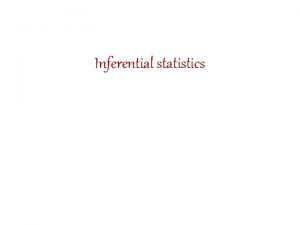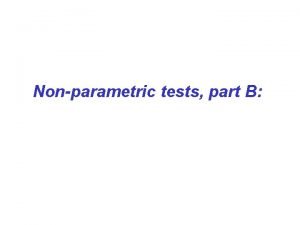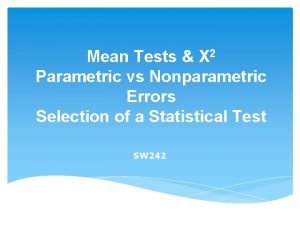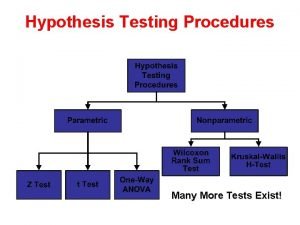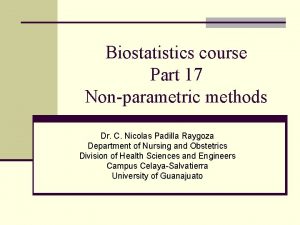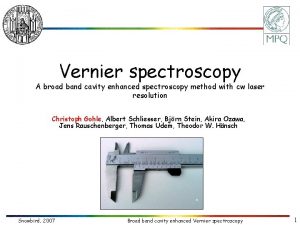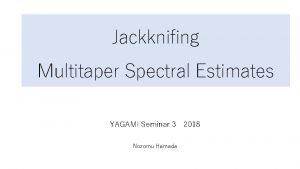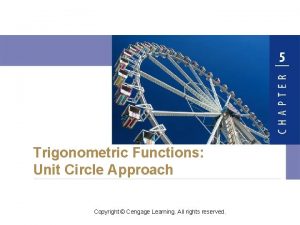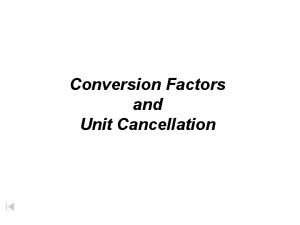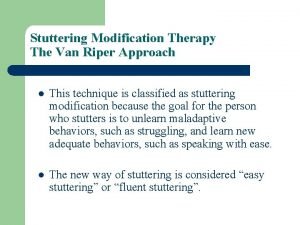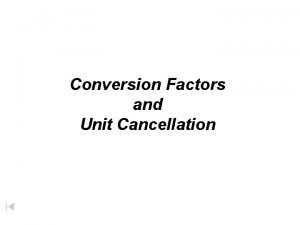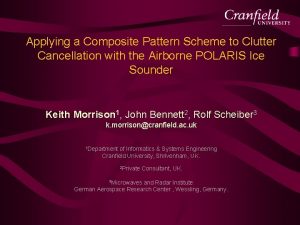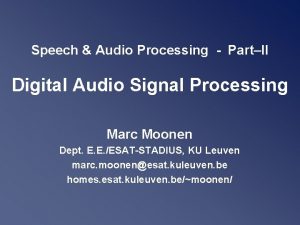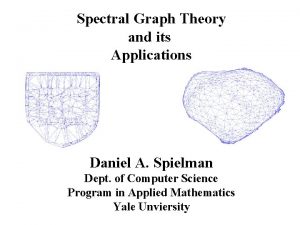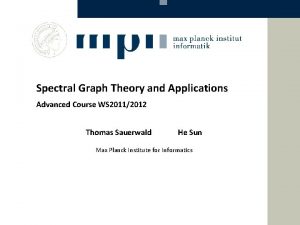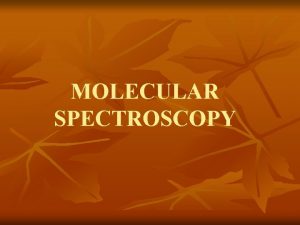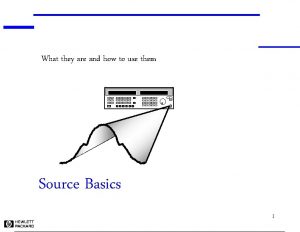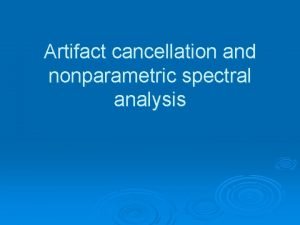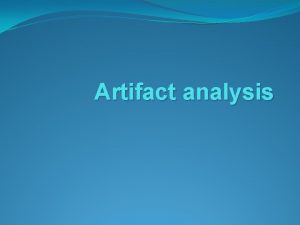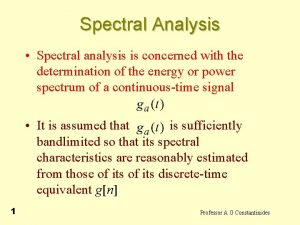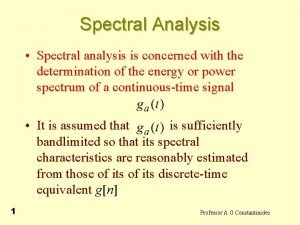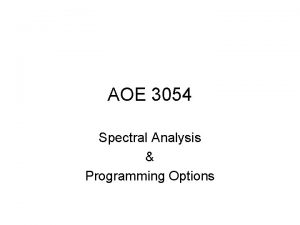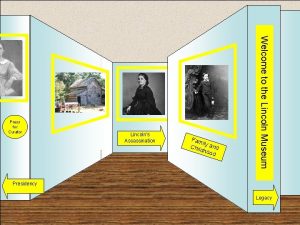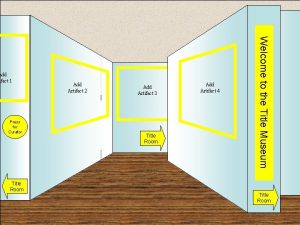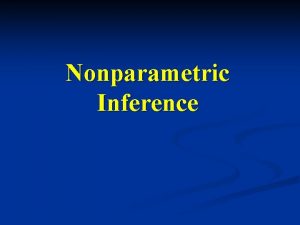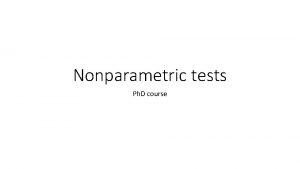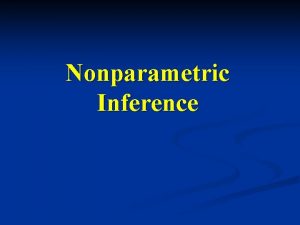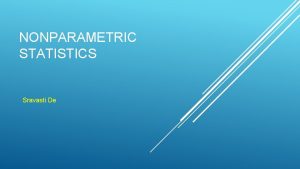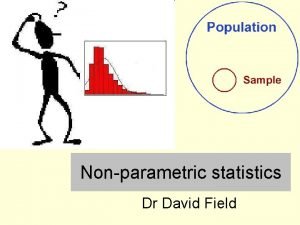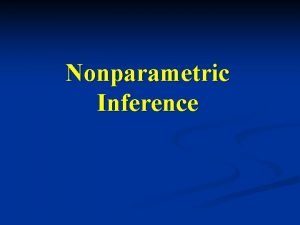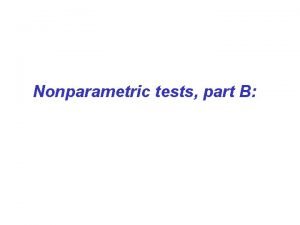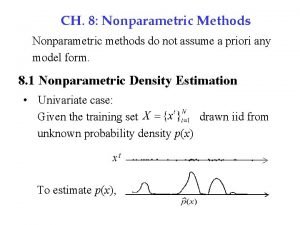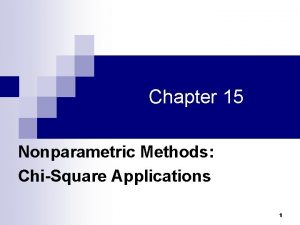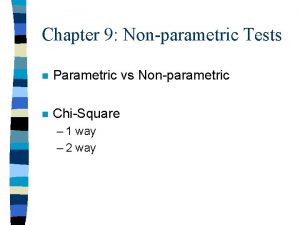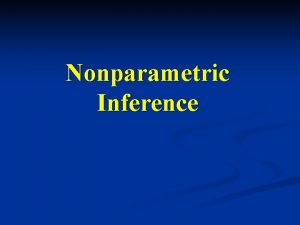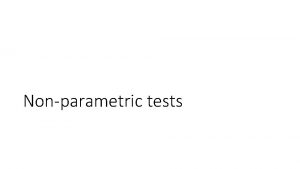Artifact cancellation and nonparametric spectral analysis Outline Artifact



























- Slides: 27

Artifact cancellation and nonparametric spectral analysis

Outline Ø Artifact processing Ø Artifact cancellation Ø Nonparametric spectral analysis

Introduction Ø Artifact processing l l Rejection cancellation Rejection main alternative • one would hope to retain data l Cancellation requirements • clinical information • no new artifacts • spike detectors l l Additive/multiplicative model Artifact reduction using linear filtering

Artifact cancellation Ø Using linearly combined reference signals Ø Adaptive artfact cancellation using linearly combined reference signals Ø Using filtered reference signals

Linearly combined reference signals Ø Eye movements & blinks l l several referene signals positioning additive model EOG linearly trasferred to EEG • weights

In detail Ø Uncorrelated Ø Mean square error Ø Minimization, differentation Ø Spatial correlation, cross correlation l l fixed over time zero gradient Ø Estimation l blinks, eye-movements at onset

In detail 2 Ø Number of reference signals Ø Only EOG cancelled Ø ECG Ø Rejection used a lot (in MEG) l expect when lots of blinks (ssp)

Adaptive version Ø Time-varying changes Ø Tracking of slow changes Ø Adaptive algorithm l l LMS weight(s) function of time • optimal solution changes with time l l method of steepest descent negative error gradient vector

In detail Ø Parameter selection l l Ø time noise Expectation l l instantaneous value zero setting performance estimation fluctuation of weights

Filtered reference signals Ø EOG potentials exhibit frequency dependence l l in trasfer to EEG sensor through tissue blinks and eye movements Ø Improved cancellation with transfer function replacement l l l spatial and temporal information v 0 estimation FIR (lengths)

Details Ø Stationary processes l l Second order characterisrics Correlation information fixed

Details 2 Ø No a priori information l can be implemented, modified error Ø Also adaptive version exists l a priori impulse responses calculated at calibration

Nonparametric spectral analysis Ø Richer characterization of background activity that with 1 D histograms Ø EEG rhythms Ø Correlate signals with sines and cosines Ø When? l Gaussian stationary signals • Stationary estimatation l Normal spontaneous waking activity

Nonparametric 2 Ø Fourier-based power spectrum analysis l no modeling assumptions Ø Spectral parameters l interpretation

Fourier-based power spectrum analysis Ø Power spectrum characterized by correlation function (stationary) l l l If ergodic, approximate with time average estimator (negative lags) combination called periodogram equals squared magnitude of DFT

Fourier considerations Ø Periodogram biased l l l window dependent (convolution) smearing (main lobe) leakage (side lobes) • synchronized rhythm better described by power in frequency band l variance periogoram • does not approach zero with sample increase l consistency

Periodogram Ø Windowing and averaging l leakage & periodogram variance reduction Ø Windows l from rectangular to smaller sidelobes • wider main lobe, spectral resolution Ø Variance reduction l nonoverlapping segments, averaging • resolution decrease, trade-off • combinations, degree of overlap

And then what. . .

Spectral parametrs Ø Resulting power spectrum often not readilty interpreted l l Condensed into compact set of parameters feature extraction • parameters describing prominent features of the spectrum l peaks, frequencies • general usage

Spectral choices Ø Visual inspection l l format selection assessing represantiveness Ø Scaling l scope of the analysis

Parameters Ø Power in frequency bands Ø Peak frequency Ø Spectral slope Ø Hjort descriptors Ø Spectral purity index

Power in frequency bands Ø Fixed/statistical bands l l alpha, beta, theta etc. from data Ø Ratio of, absolute power l comparison, nonphysiological factors

Peak frequency Ø Frequency, amplitude, width Ø ad hoc methods for determining peaks Ø more than just maximum l median, mean

Spectral slope Ø EEG activity made of 2 component l rhythmic, unstructured Ø Based on decay of high frequency components l one parameters approximation • least squares error Ø Quantifcation of EEG Ø Preconditioning of power estimate

Hjort descriptors Ø Spectral moments l l l H 0 (activity) H 1 (mobility) H 2 (complexity) Signal power, dominant frequency, bandwidth Ø Effectively in time domain Ø Clinically useful Ø

Spectral purity index (SPI) Ø Heuristic Ø Reflects signal bandwidth (H 2) Ø How well signal is described by a single frequency l noise susceptibility

Summary Ø Artifact cancellation l l reference signals linear combinations, filtering • adaptive version(s) Ø Spectral parameters l nonparametric • no modelling l parametric • interpretation
 Parametric test and non parametric test
Parametric test and non parametric test Explain the types of statistics
Explain the types of statistics Nonparametric test
Nonparametric test Parametric vs nonparametric test
Parametric vs nonparametric test Is parametric data normally distributed
Is parametric data normally distributed Nonparametric methods
Nonparametric methods Parametric nonparametric 차이
Parametric nonparametric 차이 Vernier spectroscopy
Vernier spectroscopy Yagami doc
Yagami doc Trig cancellation property
Trig cancellation property Adani visitor gate pass
Adani visitor gate pass Srinivas kotni
Srinivas kotni Cancellation of units
Cancellation of units Van riper stuttering
Van riper stuttering Pcda defence travel system
Pcda defence travel system Unit cancellation
Unit cancellation Clutter cancellation
Clutter cancellation Trade offers loans
Trade offers loans Feature engineering
Feature engineering Keralartconline. com
Keralartconline. com Digital audio and speech
Digital audio and speech Pgl cancellation policy
Pgl cancellation policy Explorica travel protection plan
Explorica travel protection plan Examples of quote sandwiches
Examples of quote sandwiches Spectral graph theory and its applications
Spectral graph theory and its applications A brief introduction to spectral graph theory
A brief introduction to spectral graph theory Factors affecting width and intensity of spectral lines
Factors affecting width and intensity of spectral lines Spectral regrowth
Spectral regrowth

